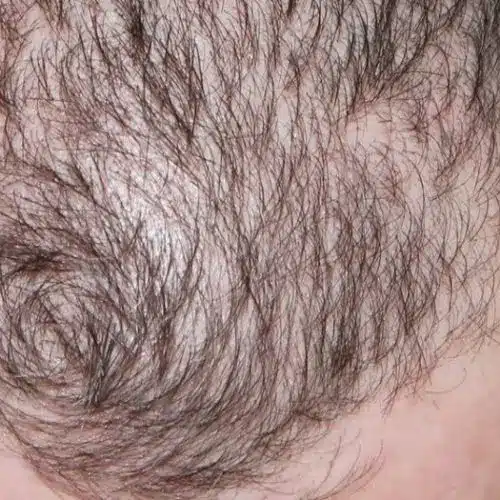
You may have heard the term “alopecia.” Many of my patients believe that alopecia refers to a specific type of hair loss, namely the autoimmune type of hair loss known as Alopecia Areata. In reality, alopecia simply meaning hair loss, divides into different subtypes with various causes and treatment algorithms. If your hair is thinning, you have alopecia. Let’s break it down.
TYPES OF ALOPECIA (HAIR LOSS)
SCARRING AND NON-SCARRING HAIR LOSS
If you are dealing with hair loss, it’s important to understand that there are two broad categories of alopecia: scarring and non-scarring. Inflammation of the hair follicle causes scarring alopecia (aka cicatricial alopecia), resulting in permanent hair loss. Once that follicle is gone, it’s gone for good. There is also a “point of no return” in non-scarring alopecia but, if treated early, these follicles can often be rescued.
In this blog post, we’ll focus on non-scarring alopecia. Refer to my other blog post for more information on scarring alopecia. Non-scarring alopecias include androgenetic alopecia (i.e. male- and female-pattern hair loss), telogen effluvium, alopecia areata, trichotillomania, and a few more rare sub-types. Let’s talk about these subtypes and I’ll give you an algorithm that will help you to identify which type of hair loss you have.
ANDROGENETIC ALOPECIA (MALE/FEMALE PATTERN HAIR LOSS)
Androgenetic alopecia (AGA) is colloquially known as “pattern” hair loss-i.e. male-pattern hair loss (MPHL) and female-pattern hair loss (FPHL). This is by far the most common type of hair loss. While more common in men than women, it is quite common in both. AGA occurs in at least 80% of men and around 50% of women by age 70. It often runs in families and is hormonally-mediated. In male-pattern hair loss, the front of the hairline recedes and the hair on the crown of the scalp gets thin. Female-pattern hair loss typically starts as thinning in the center of the scalp (the crown) and expands from there.
Treatment options for AGA include Minoxidil (this is generic Rogaine), Spironolactone, Finasteride/Dutasteride, low-level laser therapy, platelet-rich plasma injections, and hair transplantation.
Minoxidil
Minoxidil is a highly effective and easy-to-use medication for AGA and should be part of nearly every AGA sufferer’s regimen. It works by terminating the shedding phase early and lengthening the growing phase. It also increases the thickness of hair shafts. I like to explain its mechanism by telling patients that Minoxidil promotes the transition of hairs from the shedding phase to the growth phase by pushing out the old, stagnant hairs and bringing in thicker-caliber hairs. Because of this, Minoxidil can sometimes cause increased shedding and thinning at first. This can be disconcerting for patients, but it is really a good sign and means that it is doing its job.
Minoxidil Treatment & Side Effects
Minoxidil comes as a solution or a foam. They both work, so this is totally up to your preference. I recommend 5% for both men and women. Some women’s minoxidil is 2% and is recommended for twice-daily use. 5% has been shown to be equally effective and safe and only has to be used once daily. Side effects are minimal with minoxidil. It can cause irritation on the scalp but this is typically short-lived and resolves within a few weeks.
Minoxidil can also lead to the growth of unwanted hair on areas near the scalp, such as the forehead and ears, so make sure you are careful to apply it only to areas where you want hair to grow. Systemic side effects like headaches and leg swelling are rare. We are starting to use oral minoxidil in dermatology and this will likely be a very important part of our armamentarium in the future.
Timeline Of Minoxidil Treatment
It is important for me to note here that AGA (and hair loss in general) requires patience (like a lot of patience) and proper expectations. Ideally, we will get all the hair back but, in most cases, that is not realistic. Oftentimes I’ll call it a win if we can simply halt the progression of the hair loss. I’ve heard a rumor that if you use Minoxidil and then stop, your hair will be thinner than before you started.
Fortunately, this is not true, or at least not because of the Minoxidil (it would be because your hair loss would have progressed over that period of time anyway). Because of these expectations, I recommend that my patients plan on using Minoxidil indefinitely. I certainly plan on using mine for the rest of my life. After all, my hair loss isn’t going to give up on me any time soon so it’s just something I’ll have to continue to treat.
TELOGEN EFFLUVIUM Hair loss
Telogen effluvium (TE)-TE is an interesting type of hair loss that appears to be caused primarily by major stressors to the body. This can include both emotional and physical stressors, such as a major illness, hospitalization, surgery, pregnancy and postpartum, eating disorders and crash diets, hypothyroidism, etc. Telogen refers to the stage of the hair during TE and it is important to understand the hair cycle to understand this type of hair loss, so let’s talk about that briefly.
Hair Cycle & Hair Loss
The average scalp has about 100,000 hair follicles. Approximately 90% of these will be in the anagen phase and 10% in the telogen phase at any given time. The anagen phase refers to the growth phase, which typically lasts for years. The longer the growth phase, the longer the hair will grow. If given enough time without a haircut, one person’s hair might grow past their waist, while another’s might stop at their mid-back. This is due to the different durations of those individuals’ anagen phase.
The telogen phase is the resting/shedding stage. The normal rate of shedding is 50-200 hairs per day. In TE, the physiologic stressors I mentioned above trigger a premature transition from anagen to the telogen phase, such that a greater percentage of the hairs are in the resting phase and the rate of shedding increases proportionally. This shedding occurs over the entire scalp, not in a pattern like a male- and female-pattern hair loss.
Timeline Of Stress Induced Hair Loss
It is important to note that the shedding and hair thinning tend to occur around months after the stressor. This is because it takes 3 months for hairs to graduate from the telogen phase and shed. When I suspect TE, I do a hair pull test to see how much shedding is going on at the moment and how many of those hairs are in the telogen phase. This increased shedding occurs over the entire scalp rather than just the crown-like in AGA. You can perform a similar test at home by combing your hair for 60 seconds over a cloth or countertop of contrasting color before shampooing. The mean number of hairs shed in patients without TE is 10. In TE, this number may be much higher, often over 100.
The prognosis for TE is quite good. Most importantly, for most people this is a self-limited problem, meaning it resolves on its own with time.
ALOPECIA AREATA
Alopecia Areata (AA) is an autoimmune type of hair loss where one’s own immune cells are attacking the hair follicles. Under normal circumstances, hair follicles have what we call “immune privilege,” meaning the immune system can’t really touch them. For some reason (we don’t know exactly why this happens), in AA this immune privilege is violated and immune cells start to attack the hair follicles.
AA usually presents as bald patches in the scalp but can involve any facial or body hair and can also be quite extensive, sometimes involving the entire scalp (totalis) or entire body (Universalis). Sometimes hair loss is accompanied by pitting and sandpaper-like roughness in the nails.
Treating Alopecia Areata
As far as workup goes, sometimes I check labs to make sure there are no other autoimmune conditions present, but I usually limit these according to symptoms patients are experiencing. Because the hair loss is due to inflammation of the hair follicles, we approach the treatment of AA from an anti-inflammatory standpoint. Steroid medications can be applied topically to or injected into the skin or taken by mouth or as an intramuscular injection to halt inflammation. I like to compound a topical medication consisting of tacrolimus, clobetasol, and minoxidil. This makes it really easy for the patient because they only have one medication to apply.
Another interesting treatment option is topical immunotherapy with squaric acid, which is a chemical that causes allergic reactions in most people who are exposed to it. This is like exposing people to poison ivy in a controlled way. Once sensitized to this allergen, every time you cause a mild immune reaction and this can serve as a distraction for the immune cells so they don’t focus on the hair follicles. Several other medications are options, including doxycycline, hydroxychloroquine, isotretinoin, methotrexate, etc. There is a medication class known as JAK inhibitors that appears to be extremely promising. Sometimes I compound this into a liquid that my patients can apply to their scalp. Once these oral medications become a feasible option, this might be a huge game-changer for AA.
TRICHOTILLOMANIA
Trichotillomania refers to self-induced hair loss due to plucking. This is usually anxiety-related and is more common in females than males and in children more than adults. The most common age of onset is early childhood to adolescence. Signs of trichotillomania include patches of alopecia with bizarre shapes, irregular borders, and scabs within the areas of hair loss. Also, the hairs within these areas tend to be of varying lengths and broken hair shafts are found on close inspection. The diagnostic test for trichotillomania is one of my favorites. You shave a small “hair growth window” weekly for several weeks and see if that area demonstrates normal dense hair regrowth. If it does, then you know the hair loss is self-induced and would otherwise grow normally. Treatment is typically focused on addressing underlying anxiety.
Did you know that board-certified dermatologists are hair and nail experts? We are! Don’t let your hair loss progress to the point of no return. See a dermatologist early so you can get a diagnosis, understand the normal course of your particular type of hair loss, and treat it early.
Dr. Innes is a board-certified dermatologist and skin, nail, and hair expert in Layton, Utah. If you would like to schedule an appointment, call 801-773-4865 or schedule online by going to tannerclinic.com/appointments. You can learn more at https://tannerclinic.com/dermatology or on social media (Follow @thefrugalderm on Facebook, Instagram, and Youtube).


